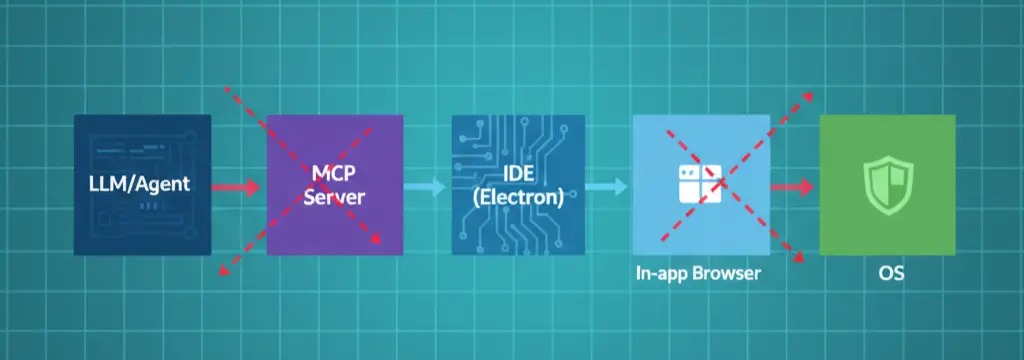A proof‑of‑concept published this week shows how a malicious Model Context Protocol (MCP) server can inject JavaScript into the built‑in browser of an AI IDE (e.g., Cursor/Windsurf/VsCode/ClaudeCode) and then leverage the editor’s privileges for system actions. This post avoids rehash and focuses on what practitioners need: a clear threat model, a safe lab plan to reproduce (without destructive payloads), generic detections you can wire into your telemetry today, and a security baseline for MCP deployments.
Key context:
- PoC impact (news + demo): Rogue MCP servers can replace login pages inside Cursor’s in‑IDE browser and harvest credentials; the same capability can lead to workstation compromise (CSO Online, Nov 13, 2025; Knostic deep‑dive, Nov 5, 2025).
- Standard & ecosystem: MCP is an open protocol that connects LLM apps to tools/data; clients/servers exist across vendors (Anthropic/GitHub/OSS). Misconfigurations and weak session handling have already produced CVEs and field‑grade abuse paths.
- Electron reality: In‑IDE browsers are Electron webviews. Security settings (contextIsolation, sandbox, no Node for remote, strict CSP) often decide whether a UI compromise stays in the renderer or escalates to the OS.
Threat model: where this exploit actually lives
- Boundaries
- LLM/Agent ↔ MCP client ↔ MCP server ↔ IDE (Electron) ↔ in‑IDE browser ↔ OS.
- Assets
- Source code, credentials/tokens, SSH material, organization secrets, local files, IDE privileges.
- Adversary paths
- Malicious or hijacked MCP server returns active content (HTML/JS) to the in‑IDE browser; content manipulates UI flows (credential capture) or tries to escape the renderer via weak Electron settings (e.g., enabled Node, missing isolation, permissive IPC/preload).
- Related ecosystem issues raise risk: predictable/reused MCP session IDs (CVE‑2025‑6515) enable session takeover; client‑side command injection (CVE‑2025‑6514) abuses crafted authorization URLs.
- Assumptions
- Developers add third‑party MCP servers for convenience; defaults may be permissive.
- Teams lack network egress controls for IDE processes; logs from Electron/IPC are sparse by default.
Reproducing it safely
Goal: Reproduce the class of issue and validate mitigations without executing real malware.
- Environment
- Disposable VM (no prod creds), snapshot enabled.
- IDE under test: Cursor or Windsurf (latest), default + hardened variants.
- Mock MCP server under your control; two profiles: benign and “attacker.”
- Instrumentation: process tree, file I/O events, network egress (domain/port), IPC/Electron warnings.
- Procedure
- Wire IDE to the benign MCP server; confirm normal flows.
- Switch to attacker server that returns a crafted HTML page (login impostor + harmless JS markers).
- Observe: in‑IDE browser navigation, form capture attempts, outbound requests, attempts to use special protocols or preload bridges.
- Flip hardening toggles (see below) and repeat. Ensure behavior changes (blocked actions, console warnings, reduced surface).
- Evidence to collect
- Renderer → unexpected child processes or helpers.
- Outbound connections from IDE to unallowed MCP hostnames or raw IPs.
- File access attempts from IDE renderer to sensitive paths (~/.ssh, project .env, keychains).
- IPC usage or errors indicating blocked Node/remote bridging.
What to watch in telemetry
These are vendor‑neutral hints you can adapt to OSQuery, Sigma, or your SIEM.
- Process lineage
- Parent process in {
Cursor,Windsurf,Electron} spawning shells or platform installers.
- Parent process in {
- File events (denylist paths)
- Actor = IDE/Electron process AND path ∈ {
~/.ssh/*,~/.config/*/tokens*, project*.env}
- Actor = IDE/Electron process AND path ∈ {
- Network egress
- New outbound to MCP hosts outside your allowlist following an MCP session start.
- DNS
- Sudden spikes to newly observed MCP domains; mismatches between configured MCP endpoints and resolved targets.
- Renderer security signals (if you can tap logs)
- Warnings about disabled
contextIsolation/sandbox, attempted use ofremote, window open/navigation to external origins.
- Warnings about disabled
Pseudocode (conceptual):
- Processes: parent in (Cursor, Windsurf, Electron) AND child in (bash, zsh, cmd.exe, powershell, wscript, osascript)
- Files: actor in (Cursor, Windsurf, Electron) AND path matches (ssh keys, tokens, .env)
- Net: dest_domain NOT IN mcp_allowlist AND proc in (Cursor, Windsurf, Electron)
Ship‑ready hardening
- Electron/IDE
contextIsolation: trueacross renderers.sandbox: true; avoid disabling sandbox via Node integration.- Do not enable Node.js for any remote/untrusted content; keep
remoteAPIs off. - Define a strict CSP (no
unsafe-eval, tightscript-src), limit navigation/new windows. - Validate IPC senders; limit or eliminate preload bridges to the minimum.
- MCP security baseline
- Allowlist MCP servers; prefer local/stdio for sensitive tooling; if HTTP(S) needed, require TLS and verify pins/org.
- Session IDs: cryptographically random, globally unique; never reuse or expose pointers/addresses as IDs.
- Audit/log: server instructions/tool descriptors, tool invocations, and unexpected schema fields.
- Policy‑as‑code (concept): gate tool actions by origin and intent (e.g., block filesystem writes unless explicitly approved by a rule/user step).
- Network
- Egress control for IDE/Electron to the MCP allowlist only; proxy inspection for HTML/JS “UI pages” returned by MCP.
- Alert on raw IP connections, unusual ports, or domain mismatches.
Pre‑flight checks
- Renderer isolation on (contextIsolation) and sandbox enforced.
- No Node in remote content; preload minimized and reviewed.
- MCP server allowlist + TLS (pinning optional, encouraged).
- Session IDs: strong RNG; no reuse; no pointer‑derived IDs.
- Egress to MCP restricted; detections firing on anomalous proc/file/net.
- Attack page can’t exfiltrate secrets or spawn OS helpers under hardening.
Open threads
- Public defaults for Cursor/Windsurf Electron settings (isolation, sandbox, remote) in the in‑IDE browser path.
- Standardized MCP security profile (policy schema + conformance tests) akin to “baseline” CIS‑style benchmarks.
Resources:
- CSO Online - Rogue MCP servers can take over Cursor’s built‑in browser (Nov 13, 2025)
- Knostic - Deep Dive: Cursor Code Injection Runtime Attacks (Nov 5, 2025)
- MCP specification & docs (GitHub)
- MCP docs site
- Anthropic - Introducing the Model Context Protocol
- JFrog - CVE‑2025‑6515 Prompt Hijacking in oatpp‑mcp (predictable/reused session IDs)
- oatpp‑mcp (GitHub)
- JFrog - CVE‑2025‑6514 mcp‑remote command injection
- Backslash - Hundreds of MCP servers vulnerable to abuse (NeighborJack, RCE, poisoning)
- Electron - Security guide
- Electron - contextIsolation/nodeIntegration discussion
Further Reading:
- China’s AI Dual Flywheel: Why Mainland Hardware Wins First, Hong Kong Internet Later
- Meta’s $75B AI Infrastructure Bet
- DeepSeek-OCR: When a Picture Is Worth 10× Fewer Tokens
Connect
- GitHub: @0xReLogic
- LinkedIn: Allen Elzayn



Comments